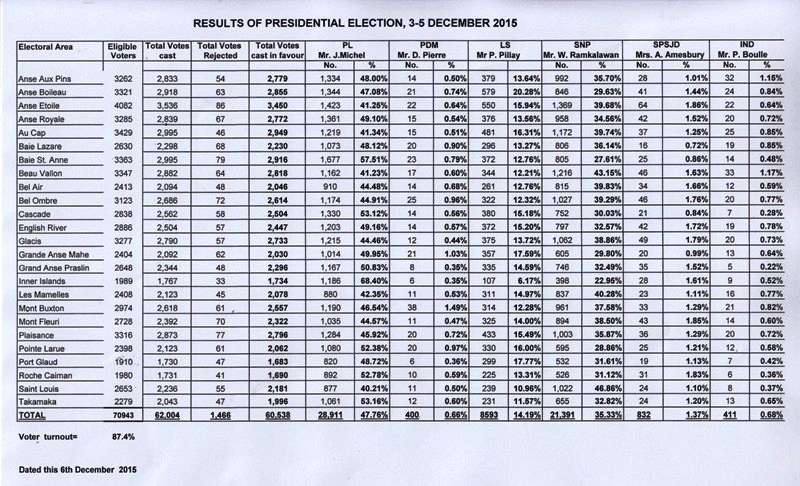Michel, Ramkalawan in run-off |07 December 2015
Seychellois voters have set the stage for a historic and bruising presidential run-off later this month after none of the six candidates could pull off the 50% plus one vote for an outright majority in the first round on Saturday.
This is the first time since the return of multi-party democracy in Seychelles in 1993 that the presidential election goes into a second round and the people will now have to decide between two candidates – Parti Lepep’s James Michel and Seychelles National Party’s Wavel Ramkalawan – who secured the most votes in the December 3-5 first round.
As the second round has to take place between seven and 14 days after the first, the Electoral Commission has said Seychellois who are eligible to vote will be called upon again to choose between incumbent President Michel and long-time rival Ramkalawan in the second round from December 16-18.
It was close to 5am that Electoral Commission chairman Hendrick Gappy announced the results at the commission headquarters at the National Library in the presence of four of the six candidates – Mr Michel, Mr Ramkalawan, Patrick Pillay of Lalyans Seselwa and Alexia Amesbury of the Seychelles Party for Social Justice and Democracy.
David Pierre of the Popular Democratic Movement and independent candidate Philippe Boullé were absent.
Also present were members of the diplomatic community in Seychelles, representatives of the observer missions and religious leaders.
Out of the 70,943 eligible voters, there were a total of 62,004 votes cast among which 60,538 were valid votes and 1,466 rejected ballots. The voter turnout was 87.4%.
Incumbent President, 71-year-old Michel who won 28,911 votes (47.76%), said the result showed that Parti Lepep is still dominant.
“We got more votes than any other party. We missed by only two percent. We are ready for the second round,” said Mr Michel.
Mr Michel’s closest challenger was 54-year-old Anglican priest Ramkalawan who scored 21,391 votes (35.33%).
Mr Ramkalawan thanked the other opposition parties and his voters for helping force a second round for the first time ever and said “with 52.23% of the votes the opposition has more supporters”.
He added: “Michel, we will come after you as the army of the opposition.”
Mr Michel scored more than 50% in seven out of the 25 districts with the highest score of 68.40% (1,186 out of a possible 1,734) coming from the inner islands. The other six districts where he won more than 50% are Baie Ste Anne (57.51%), Cascade (53.12%), Grand Anse Praslin (50.83%), Pointe Larue (52.38%), Roche Caïman (52.78%) and Takamaka (53.16%).
This is 17 districts less than in 2011 when he won all but two districts to total 31,966 votes (55.46%) to be re-elected President for a second five-year term. Mr Michel’s poorest score was registered in St Louis with 877 votes (40.21%) out of a possible 1,683 votes.
As for Mr Ramkalawan, he also got fewer votes than in 2011 when he totalled 23,878 (41.43%) and after scoring more than 50% once then – 53.10% at St Louis – he did not go over the 50% margin this time as his best percentage score was 46.86% again at St Louis after he amassed 1,022 of a possible 1,683 votes. He also beat Mr Michel in Beau Vallon 43.15% to 41.23%.
Mr Ramkalawan’s lowest score was from the inner islands – 398 votes out of a possible 1,734 (22.95%).
The margin between Mr Michel and Mr Ramkalawan is 7,520 votes – 568 less than in 2011 when the former beat the latter by 8,088 votes (31,966 against 23,878).
The scores of the other four candidates in the first round are as follows: Mr Pillay (8,593 votes for 14.19%), Mrs Amesbury (832 votes for 1.37%), Mr Boullé (411 votes for 0.68%) and Mr Pierre (400 votes for 0.66%).
Mr Pillay, a former minister and ambassador in the Parti Lepep government, lawyer Amesbury, the first female presidential candidate in the history of Seychelles, and Mr Pierre, the leader of the opposition in the National Assembly, were running for the presidency for the first time.
Of the three new entrants, Mr Pillay has surely drawn away more support from the two main parties – Parti Lepep and Seychelles National Party – with his score of 8,593 votes (14.19%).
Dividing Mr Pillay’s percentage into two and giving those to the two main parties would mean a win for Parti Lepep with a score of 54.85% and the Seychelles National Party would have finished with 42.42%.
This was Mr Boullé’s fourth unsuccessful bid in a presidential election as an independent candidate and his score dropped from 956 in 2011 to 411 this year, while Mr Pierre is the biggest loser with just 400 votes to finish last in the race involving six candidates.
The accompanying table shows the results district by district.






